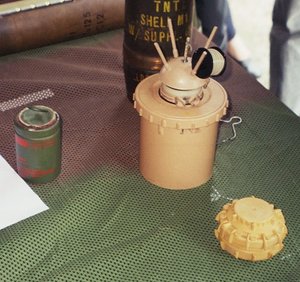by Larry
March, 2013Toys Inspire Anti-Mine DeviceLandmines can still explode and cause death or injury decades after being deployed. Egypt, for example, is believed to have 23 million potentially still active landmines that were scattered in World War II and in that country's subsequent conflicts with Israel.
Is there at least a similar effort to remove and destroy them? Hardly. Despite roughly 10,000 to 20,000 people being killed each year by landmines and their injuring another estimated 15,000 to 30,000 victims annually, and though more than half the fatalities or wounded are children, major attempts to eradicate landmines or their lethal modern cousins, cluster bombs, are not being made. Instead, the net numbers of these weapons are increasing. A concerted and systematic demolition effort to rid countries of landmines and cluster bombs would be better. However, in its absence at least one new device shows promise for helping reduce this threat. A pair of Afghan brothers, designer Massoud Hassani and Mahmud Hassani, age 29 and 27 respectively, refugees from a Taliban controlled part of Afghanistan and now living in the Netherlands, as kids used to make large, wind-blown balls out of bamboo frameworks. Today they are using this as a model for an anti-mine device which looks much like sagebrush or tumbleweed. It is blown about a landmine area till it sets off one of the explosives, after which the device is cheap and easy enough to reconstruct and put back in service till the next such detonation. Hassani calls the devices "mine kafons," short for mine exploders. Small frisby-like attachments at the ends of the bamboo greatly increase the contact surface and create resistance to the wind so that the balls get pushed around by breezes. A GPS apparatus in the inner core of the device records where it has already traveled, indicating on a digital map areas that are now relatively safe for people to walk. Demonstrations of the mine kafons have been impressive, yet much more testing and some improvements may be needed to perfect the invention and assure that their "feet" (instead of human ones) make needed contact with and detonate the mines. Assuming they can raise the needed funds via donations, the intention is that the brothers' prototype devices will be tested extensively until the brothers and others are completely sure of their anti-mine utility. From that stage, they hope later this year to introduce the kafon in Afghanistan, where they or similar devices appear to be urgently needed to help clear extensive areas of landmine distribution. If they prove their worth there, they could be vital in many other mine-strewn areas of the world as well. Massoud Hassani is not a novice at this type project. He envisioned the mine kafons in 2010 while a student at the Netherland's prestigious Design Academy Eindhoven. Primary Source: Afghan Toy Inspires Giant Wind-Propelled Landmine Destroyer. Anonymous in Asiantown.Net; January 5, 2013. |
